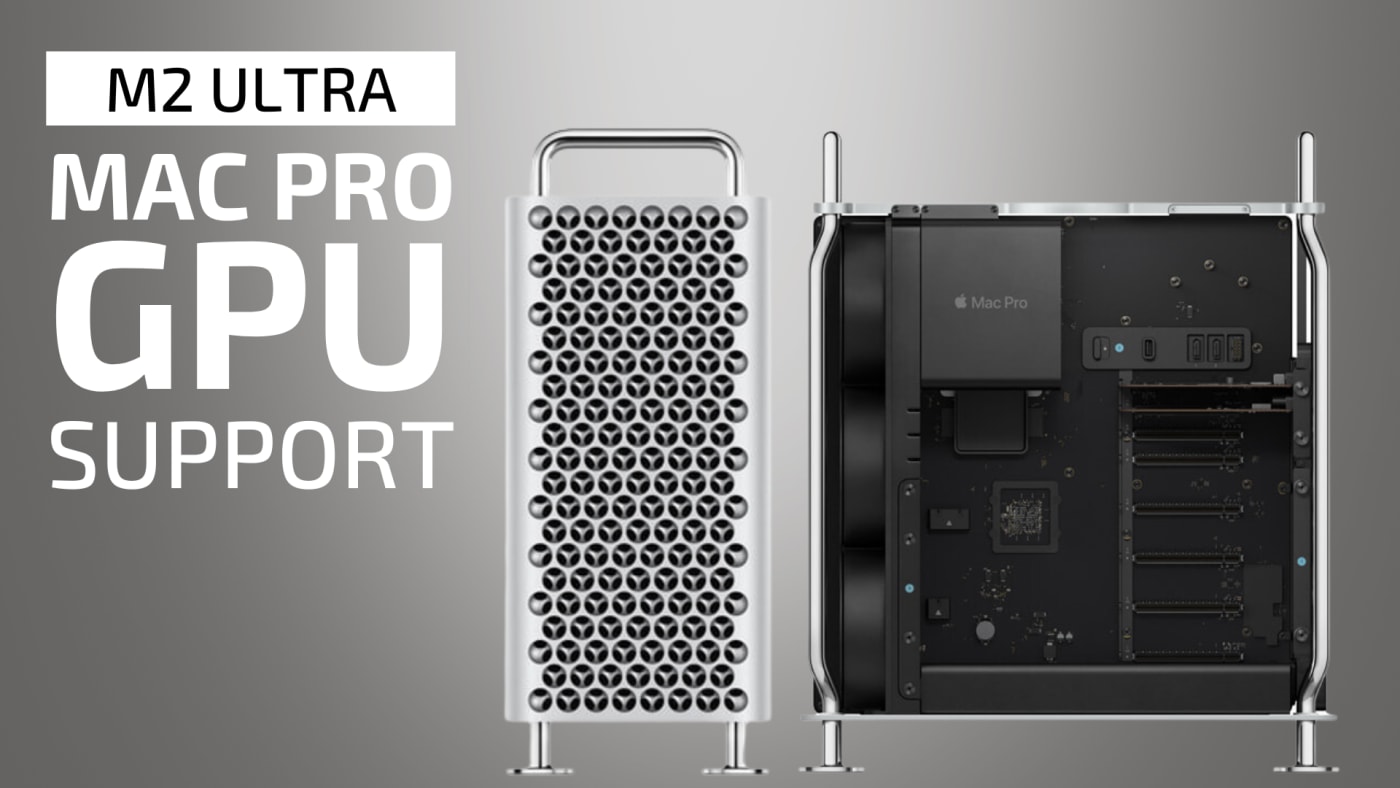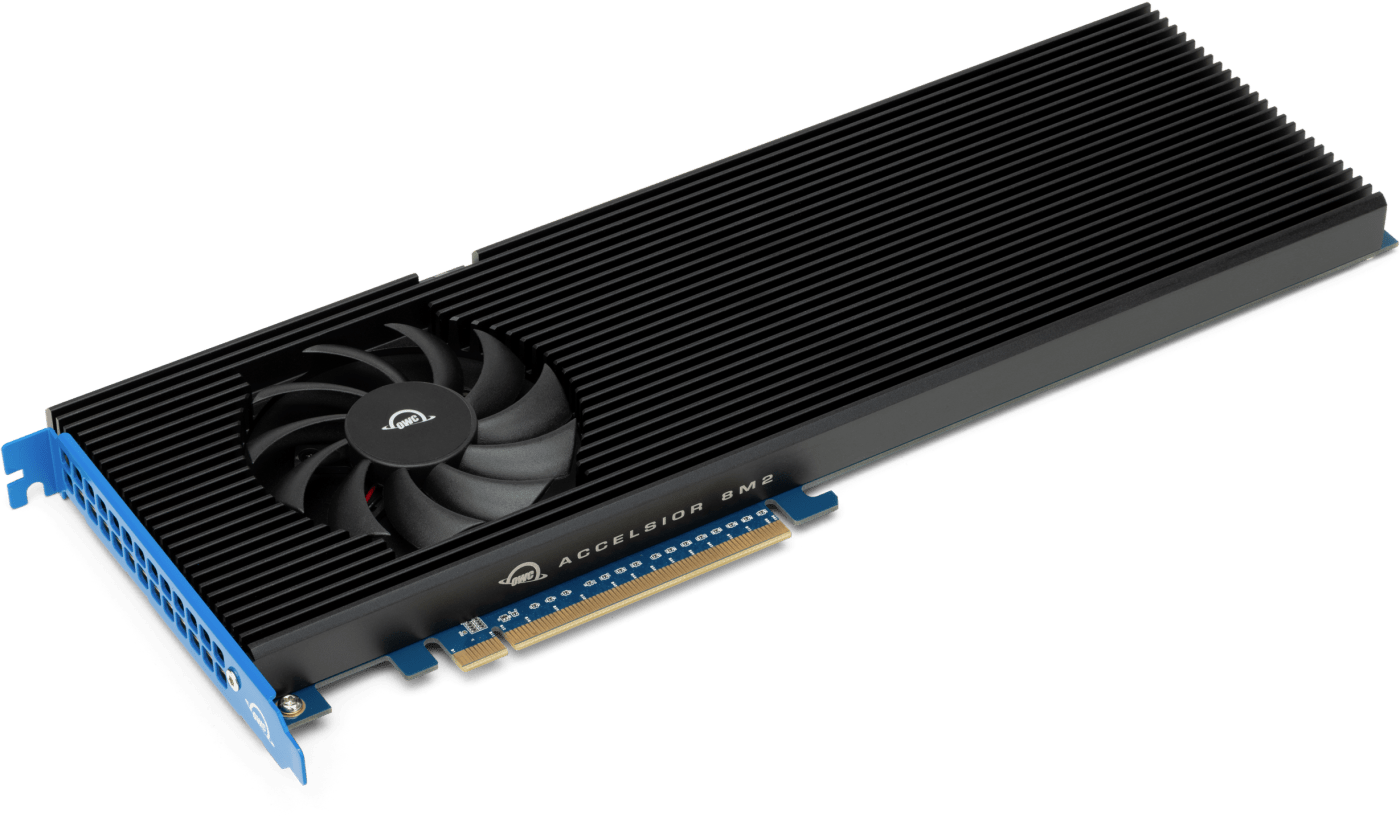Why the M2 Ultra Mac Pro Doesn't Support Discrete GPUs
Why does Apple's latest Mac Pro drop support for discrete GPU cards? And can it really be considered a "Pro" tower without it?
Wayne Grayson • Jul 24, 2023

When Apple unveiled the new Mac Pro during the WWDC 2023 keynote last month―a behemoth of a workstation with Apple's most powerful system on a chip (SOC) to date at its core and loads of expansion through six available PCIe ports and eight Thunderbolt ports―the knee-jerk reaction from scores of professionals was that this would be the Mac they always wanted. Nay―the Mac they always needed.
Unfortunately, the dreams of many of those professionals were dashed shortly after the keynote when it was revealed that none of those PCIe ports would support discrete GPUs.
This omission was particularly odd because Apple dedicated a sizable chunk of the Mac Pro's introduction to discussing all the new capability the workstation would bring animators, video editors, and those working on artificial intelligence and large language models.
These are all applications that would benefit from GPU expansion via PCIe, something the previous generation Mac Pro, powered by Intel's Xeon CPU, did support. So why doesn't the new Mac Pro support it?
In short, it's all the M2 Ultra's fault.
Unified Memory Architecture means no room for discrete GPUs...for now
Though the new Mac Pro doesn't look all that different from the 2019 Intel-based version, the introduction of Apple's ARM-based M2 Ultra SOC brings a radical reworking of the Mac Pro's computing architecture.
During an interview with Daring Fireball's John Gruber, Apple senior vice president of hardware engineering John Ternus said the M2 Ultra Mac Pro drops support for discrete GPUs due to the fact that there's currently no good way to use discrete GPUs in tandem with the M2 Ultra's integrated GPU.
That's because Apple silicon is built upon a Unified Memory Architecture where CPU and GPU memory are accessed from a single pool. This has resulted in huge efficiency and performance boosts on Apple's M-Series chips to date and Apple says the new Mac Pro is no different.
"I think, fundamentally, we built our architecture around this shared memory model and that optimization," Ternus explained. "It's not entirely clear to me how you bring in another GPU and do so in a way that is optimized for our system. It just hasn't been a direction that we want to pursue."
Skating to where the puck is headed
The M2 Ultra gets its "Ultra" moniker from the fact that it's made by dieing together two M2 Max chips. The Ultra boasts a 24-core CPU and an integrated GPU that can be configured with up to 76 cores.
The Ultra makes 192 GB of unified memory available to the CPU and GPU at a bandwidth of 800 Gbps.
"The CPU can get unbelievable bandwidth and the GPU can get unbelievable capacity of memory," Ternus told Gruber. "And it enables these workflows and these use cases and models that you couldn't do before."
The new Mac Pro―and really Apple's whole undertaking of developing its own silicon―illustrates well the company's long-held philosophy of "skating to where the puck is headed," rather than trying to design solely around the demands of the current market. The company built a huge lead in smartphones and tablets with its A-Series SOCs which have long exhibited desktop-class power. To date, Apple still retains a comfortable lead over rivals like Qualcomm, Samsung, and Google when it comes to ARM-based smartphone chips.
But the introduction of the M1 chip―a bet that Apple silicon could meet the demands of Mac users and support applications built for Intel chips through the Rosetta 2 translation layer―was a huge bet on the future of Apple that has turned out to be wildly successful. And, Apple being Apple, the company isn't content on following up that success with using its technology to meet what they deem inferior solutions halfway.
SOCs are the path forward. And for any expansion upon what a given SOC offers to be viable, at minimum, it must be able to integrate with the overall unified architecture. Not the other way around.
One aspect about the new Mac Pro that drives home the benefits of the M2 Ultra is that the Ultra's integrated GPU is not only as powerful as the Afternburner card offered with the 2019 Intel Xeon-based Mac Pro, it's as powerful as seven Afterburner cards combined. An M2 Ultra Mac Pro is capable of playing back 22 simultaneous streams of 8K ProRess 422 video.
Another benefit of M2 Ultra is the SOC's dedicated media engine, designed to accelerate video processing. With M2 Ultra, Apple says video processing is 50% faster in DaVinci Resolve, while rendering in Octane is 3x as fast when compared to a Mac with an M1 Ultra chip.
The M2 Ultra's capability is no doubt impressive. And when you take all these specs and combine them with Ternus' remarks to Gruber in that post WWDC interview, Apple's stance on the decision to exclude GPUs from PCI expansion on the new Mac Pro appears to be: "M2 Ultra offers more than enough capability without discrete GPU support and its uniform memory architecture provides a better overall experience anyway."
Apple is aware of Nvidia's lead in the AI space and are just fine ceding that advantage at this point. However, Apple also added in its keynote introduction of the Mac Pro that M2 Ultra is capable of training massive machine learning workflows discreet GPUs can't handle because they would run out of memory. That is a claim obviously light on specifics, but it nonetheless shows Apple was and is well aware of what the perception of excluding GPU support from Mac Pro would be.
Instead of working on optimizing Nvidia cards for future Apple SOCs, it's more likely that Apple would rather develop a new version of the Afterburner, a PCIe card that will integrate with M-Series architecture. Either that, or continue to focus on making the M-Series integrated GPUs more and more powerful.
So who is the new Mac Pro for anyway?
A lot of commentary lamenting the lack of discrete GPU support seems to suggest that GPUs are the only reason you'd want PCI expansion, and without it, what's the point of the Mac Pro when the Mac Studio exists?
The Mac Studio is a wonderful machine. A delightful, compact, and extremely powerful desktop computer. And the new M2 Ultra variant is likely more computer than 80% of professionals really need.
The Studio is an extremely performant desktop. But the Mac Pro is aimed at professionals who need a bit more than just performance. Specifically, the Mac Pro is aimed at providing professionals with more flexibility in tailoring their machine to their needs.
That's really the only reason the Mac Pro still comes in a tower form factor. As the Mac Studio illustrates, a powerful computer no longer needs to be a big computer. But the Mac Pro isn't solely focused on power. It's focused on adaptability and support for huge amounts of storage and networking or audio cards.
Beyond expansion of that sort, there's really no reason for a Mac tower to exist anymore.
The Mac Pro is aimed squarely at video, audio, AI, and other professionals that need huge amounts of storage―faster than ever thanks to PCIe Gen 4 slots on the new Mac Pro―or application-focused expansion like networking cards, or audio cards.
"Well there are some use cases in audio workflows and some other workflows where just a massive amount of super high-speed storage is really key," Ternus told Gruber. "So bringing high-speed storage on PCI can do that; enable things that you'd struggle a bit more to do on a Mac Studio.
"Some of the color grading workflows on some of the big projects require incredibly fast networking, so custom networking cards to be able to do that," Ternus continued. "So there's a bunch of different things. And I think, again, people have built whole workflows and whole infrastructure around PCIe cards and all that so what we were able to do here is bring all the benefits of Apple silicon to that workflow and to that infrastructure and it will just plug right in and go. We've done a ton of work with the card manufacturers to make sure they're ready to go on day one and we think people are going to be really thrilled with it."
Some things are only possible on Mac Pro
The Mac Pro has always been a machine built to grow with you. Countless studios and post-production houses out there still use Mac Pros more than a decade old because they know their PCIe cards just work on those workstations. The new Mac Pro gives those professionals a much needed performance update with capabilities that were simply unthinkable just a few years ago.
Take OWC's Accelsior 8M2 for instance. With Gen 4 PCIe support, this is the fastest, highest-capacity PCIe SSD available today.

Accelsior 8M2 SSD packs eight ultra-fast NVMe SSDs in one card. By equipping six of these cards into a new Mac Pro, you'd have up to 384 TB of on-board storage with speeds up to 26 Gbps.
This type of storage performance is only possible on the M2 Ultra Mac Pro with Accelsior 8M2. And beyond the PCI expansion capabilities, the new Mac Pro also has eight Thunderbolt ports, allowing you to add even more external storage, displays, and more.
These expansion capabilities make the Mac Pro the best possible option for professionals who need a workstation that gives them the ultimate possible data transfer speeds with room to grow as time goes on.
It's not a workstation aimed at all professionals, but for those who need the ultimate flexibility, the Mac Pro is still well worth the cost. even without discrete GPU support.
 USA + International
USA + International OWC Canda
OWC Canda OWC Europe
OWC Europe